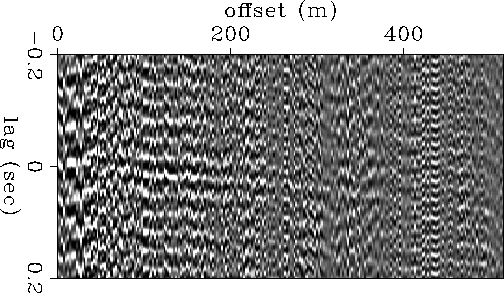




Next: Conclusions
Up: Cole: A drill-bit source
Previous: Velocity analysis at fixed
Once we have found the position of the drill bit and the
velocity that best stacks its energy, we can stack the
data along the appropriate moveout trajectory to obtain
an estimate of the drill bit source signal. This is
analogous to the signal from the accelerometer placed
on the drill string by Rector et al. Crosscorrelating
the data with this source signal estimate enhances
drill bit energy in the data.
A plot of data after such a crosscorrelation
is shown in Figure ![[*]](http://sepwww.stanford.edu/latex2html/cross_ref_motif.gif) .
Here the traces have been sorted by their offset from the well.
There is an event at zero lag on the near offsets that
can be tracked across all offsets and occurs at around
0.08 seconds on the far offsets.
It is important to note that crosscorrelation
preserves the moveout of the drill bit signal. Thus the same
search for sources can be performed after crosscorrelation.
Perhaps we will see evidence of scattering of drill
bit energy off subsurface structure.
This is one subject of future work.
.
Here the traces have been sorted by their offset from the well.
There is an event at zero lag on the near offsets that
can be tracked across all offsets and occurs at around
0.08 seconds on the far offsets.
It is important to note that crosscorrelation
preserves the moveout of the drill bit signal. Thus the same
search for sources can be performed after crosscorrelation.
Perhaps we will see evidence of scattering of drill
bit energy off subsurface structure.
This is one subject of future work.
eaeg3
Figure 8 eaeg3





Data after crosscorrelation with an
estimate of the drill bit source signal. The event at
zero lag on the near offsets is the direct arrival from the drill bit. Moveout
is preserved.





Next: Conclusions
Up: Cole: A drill-bit source
Previous: Velocity analysis at fixed
Stanford Exploration Project
12/18/1997
![[*]](http://sepwww.stanford.edu/latex2html/cross_ref_motif.gif) .
Here the traces have been sorted by their offset from the well.
There is an event at zero lag on the near offsets that
can be tracked across all offsets and occurs at around
0.08 seconds on the far offsets.
It is important to note that crosscorrelation
preserves the moveout of the drill bit signal. Thus the same
search for sources can be performed after crosscorrelation.
Perhaps we will see evidence of scattering of drill
bit energy off subsurface structure.
This is one subject of future work.
.
Here the traces have been sorted by their offset from the well.
There is an event at zero lag on the near offsets that
can be tracked across all offsets and occurs at around
0.08 seconds on the far offsets.
It is important to note that crosscorrelation
preserves the moveout of the drill bit signal. Thus the same
search for sources can be performed after crosscorrelation.
Perhaps we will see evidence of scattering of drill
bit energy off subsurface structure.
This is one subject of future work.
